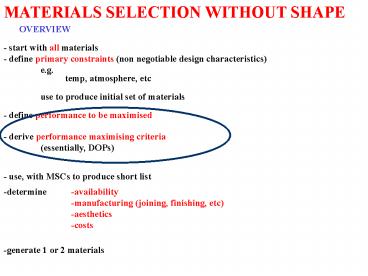MATERIALS SELECTION WITHOUT SHAPE PowerPoint PPT Presentation
1 / 11
Title: MATERIALS SELECTION WITHOUT SHAPE
1
MATERIALS SELECTION WITHOUT SHAPE
OVERVIEW
- start with all materials - define primary
constraints (non negotiable design
characteristics) e.g.
temp, atmosphere, etc
use to produce initial set of materials
- define performance to be maximised
- derive performance maximising criteria
(essentially, DOPs)
- use, with MSCs to produce short list
-determine
-availability -manufacturing (joining, finishing,
etc) -aesthetics -costs
-generate 1 or 2 materials
2
PERFORMANCE (P)
something that would be desirable to maximise,
e.g. life, portability, speed (?)
Function
e.g. a specific load must be carried
Material properties
Geometry
Size/shape of component
If
Performance index (PI) (DOP)
Maximised PI maximises p for any F and G
FINAL DESIGN NOT REQUIRED TO SELECT MATERIAL
3
EXAMPLE
Performance index for a tie rod
maximise lightness
Step 1
define desired p
i.e. as light as possible
i.e. p 1/mass (m)
Step 2
generate m in terms of F, G and M
Method
define m in terms of any combo of F,G and M
Function of rod is to support a load without
fracturing
Missing parameter is
F
Define F in terms of anything in above eqn
-lightest rod obtained by maximising (?f / ?)
4
IS THIS THE CORRECT PERFORMANCE INDEX?
should be able to choose ideal material
regardless of the final details of the operation
Function
Magnitude of force is fixed but will not affect
material choice
Geometry
Fixed length will not affect material choice
Fixed area will affect material choice
this fixes ?f
Lowest ? required
A must be a free variable, otherwise cant use
this approach
free variables must not appear in performance eqn
5
SUMMARY FOR DERIVING PERFORMANCE INDEX
identify performance attribute to be maximised or
minimised
i.e. p 1/mass (m)
generate an expression (objective function)
A
identify (or define) the free variables
identify (or define) the constraints
F and l
develop equations for constraints in terms of G
and M
A F/?f
express free variables in terms of the constraints
substitute into objective function
group variables into F,G and M
Read off performance index, M, to be maximised
6
MATERIALS SELECTION PROCEDURE
Step 1
Define Primary Constraints on MSC if possible
Mats prop (1)
exceed constraint
Select from these
Mats prop (2)
Step 2
What value M?
Generate performance index, M
M large enough to select from several mats types
7
MULTIPLE CONSTRAINTS / SINGLE GOAL
Constraints are necessary to limit choices
Too many constraints lead to no choice
Easiest solution
make initial subset based on this
select main constraint
select other constraint
make secondary subset based on this
select from mats common to all lists
If none, decrease main M (loosen main constraint)
8
More difficult solution
Mathematically couple constraints
e.g. light tie rod with specific stiffness and
strength
For stiffness constraint
(E / ?)
For strength constraint
Must fall on this line (autoranked)
combined by eliminating m
(?f / ?)
Highest possible values
l and u are fixed
9
MULTIPLE GOALS
e.g. low weight and high resistance to
corrosion how can they be compared? convert
design goals into common goal e.g. cost weighting
factors weighting factors e.g. one mat has a
fractionally higher wt saving, other a
fractionally better corrosion resistance multiply
fraction wt saving by 10 multiply fraction corr.
resist by 6 (less important) -select one with
larger product. -too subjective
10
Performance index for a small spring
identify performance attribute to be maximised or
minimised
volume (v) (minimised
generate an expression (objective function)
identify (or define) the free variables
none
identify (or define) the constraints
W
develop equations for constraints in terms of G
and M
express free variables in terms of the constraints
No need
substitute into objective function
group variables into F,G and M
Read off performance index, M, to be maximised
11
(No Transcript)

